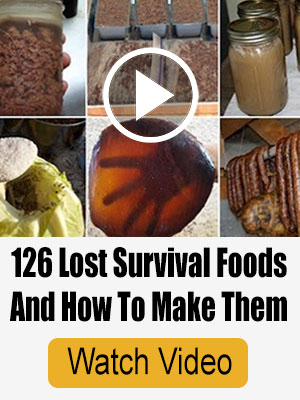Estimated reading time: 13 minutes

It’s hard to say when people first figured out that cooler temperatures keep food fresher, but the practice of refrigeration has been going on for thousands of years. On a fundamental level, refrigeration inhibits the growth of bacteria. That’s it. It also slows down the development of mold on some foods, but bacteria is the primary threat to food safety.
Most of us don’t worry about it too much, and our biggest concern with a refrigerator is finding enough room inside after a trip to the grocery store. But for anyone living off grid, alternatives to refrigeration crucial. And for any of us confronted by a power outage, it becomes a primary concern once we find the flashlights and the candles.
Regardless of the reason, it’s worth looking back at how people stored food before refrigerators were invented. Some of these techniques are fairly simple and surprisingly obvious. Others require a bit of planning, effort, and materials. What’s important is that whether they’re simple or complex, they all work.
Zeer Pots

One of the first inventions that create a cool environment is the Zeer pot. It’s simply a couple of clay pots nested inside each other with a layer of wet sand dividing them. An breeze or circulating air cause the water that has permeated the clay to evaporate, cooling the inside of the inner pot.
The Zeer pot is still used in many parts of the world where off-grid lifestyles are a way of life rather than an adventurous choice.
Root Cellars

It doesn’t take anyone long to realize that a cave is cooler than outside temperatures. It was a simple matter for people to figure out that storing food in a cave kept it fresher longer, assuming animals didn’t find their way to the food.
Unfortunately, caves are relatively rare, and someone figured out that a deep hole in the ground would produce a similar cooling effect. The result was the beginnings of the root cellar as a refrigeration concept.
Root cellars are another invention still used around the world. One of their primary benefits is their size. Anyone with a significant quantity of food that needs to be stored under refrigeration knows how limited space can be in a conventional refrigerator.
Cold Pantries

The cold temperatures of winter gave many people a simple way to keep food fresh. The juggling act was trying to manage the temperatures between refrigeration and freezing.
The result was that many back porches or small rooms with a window became makeshift refrigerators as people tried to balance heat from the house with freezing temperatures outside to keep things cold but unfrozen.
They’re sometimes referred to as cold pantries, and a window was opened or slightly shut to manage the amount of cold winter air that got inside. It was far from an accurate way to manage temperatures, but when no electricity or refrigeration technology was available, it worked.
Curiously, winter led to another alternative to refrigeration: freezing. Today, it seems like we have one of two alternatives defined as refrigeration or freezing, but when frigid winter weather was all that was available, freezing everything was the only alternative when there was no refrigerator.
Ice Boxes

Ice on lakes was harvested in winter, and the large ice blocks were stored in barns and buildings insulated by hay. The blocks of ice were then used in large metal contraptions with doors called “ice-boxes.”
Some of us remember a time when we still referred to the refrigerator in the kitchen as the ice-box. The ice for cooling is long gone, but for a few generations, it was a luxurious appliance in the kitchen.
The ice was sawn from the top of lakes and pulled from the lake for storage by horse teams. A delivery person known as “the ice-man” would then go door to door with a horse drawn wagon of ice to deliver ice for the ice-box.
Many of us still practice the ice-box technique without thinking about it too much. It’s the conventional cooler we fill with ice and take with us when we go camping.
Basements

It didn’t take people too long to figure out that the basements under their homes were cooler than the upper floors. This was especially true in basements with walls exposed to the ground. The result was a root-cellar effect, and today, many basements still offer cooler temperatures that could be an advantage for food storage.
Even a Hole in the Ground

There is a simple technique that can be employed to improvise refrigeration just about anywhere. It’s a hole in the ground, but there are a few enhancements that can make it work better.
Everything from metal garbage cans to wooden boxes, milk cans, plastic buckets, and even flower pots can be placed into a hole in the ground to keep things cool.
In its simplest form, all it takes is digging a hole about 2 to 3 feet deep and draping a large sheet of canvas or burlap into the hole. The fabric is immersed in water and wrung out and then carefully placed into the hole. The top of the fabric is held in place by a circle of rocks and anything that needs to be cooled is placed in the hole.
A cover is placed over the top and the seams around the cover are either mounded with a little dirt or more wet fabric. The evaporation from the surrounding soil keeps everything cool.
Many people would dig these holes under their cabins and line the hole with bricks. A trap door in the floor of their cabin allowed access to the in-ground refrigerator.
The Spring-Creek Effect
Another popular and commonly used refrigeration technique was a metal box in a spring creek. Many springs emerge from the ground as very cold water, and the gentle current of the spring around a metal box kept it and everything inside cool.
Water Well Cooling

Anyone with a water well on their property had access to a food cooling resource. The water in the well could chill a waterproof metal box, and even food suspended in a burlap bag deep in the well, but above the water line, would stay cool due to the evaporative cooling of the walls.
Most of these water wells had a rope on a pulley for a bucket that could also raise and lower food in a metal box or burlap bag.
Animal Husbandry
There are many reasons people raise animals for food. Chickens produce eggs. Cows and goats produce milk. And most farm animals can eventually be butchered and eaten. But there’s a side benefit we rarely consider: Keeping an animal alive keeps it fresh, and there’s no refrigeration required.
And it extends beyond farm animals to things like fish and shellfish. Many fish farms around the world remove the need for refrigerated food storage. A fish pond or pool keeps seafood available and unspoiled, and it’s the primary reason for fish farming in many instances.
Alternative Food Preservation
Many techniques have been developed over thousands of years to preserve food without refrigeration. Here are a few and it’s quite possible you’ve practice many of these techniques.
Canning

Canning involves storing food in glass jars and is usually accompanied by a processing step. A hot water bath is often used for foods with an acidic pH like tomatoes, citrus fruits, and other acidic foods that naturally inhibit bacterial growth.
Pressure canning is used for more alkaline foods like meat, fish, and beans that can succumb to bacteria more readily. The jars or cans are then stored and once again, a root cellar was often the preferred location so the cooler temperatures could add another layer of preservation.
Drying and Dehydration

From raisins to prunes to dates, drying and dehydration techniques went a long way toward preserving food without refrigeration. Drying food removes the moisture, which is another catalyst for bacterial and mold growth.
Fruits and vegetables were often dried by exposure to the sun, and even meats and fish were hung on racks in ancient times for sun-drying.
Low temperatures in clay ovens or over a smoldering fire were also used. This helped keep insects away from any exposed food that depended on sunlight for dehydration.
Smoking foods as a food preservation process was a side-effect of dehydrating anything over a fire, and the smoke also went a long way toward killing and inhibiting bacterial growth. People inevitably developed a taste for smoked foods, and the practice became more refined as smoking became both a cooking and preservation process.
Salting and Curing

Another element that inhibits bacterial and mold growth is salt. It was a plentiful resource in many parts of the world in coastal areas, and it’s one of the most ancient food preservation techniques. Long before refrigeration emerged as a way to preserve food, salting and curing foods was the traditional technique.
Some foods are preserved in a brine either in a jar, or as a preliminary step to other food preservation techniques like smoking and drying.
Other foods are dry cured, which usually required that the food be coated with layers of salt or even immersed in a mound of salt to draw out the moisture and preserve the food.
This was a common technique for meat and fish, and the results led to things like salt pork, jerky, and Scandinavian salted cod (bacalao).
Packaging
We take packaging for granted. It seems like an automatic thing with many things we buy and often appears as more of an excuse for branding and marketing rather than food preservation.
In actual fact, many food packages go a long way toward keeping food fresh and safe to eat. Think about it. How often do you see the caution: “Refrigerate after opening.” The obvious solution if you don’t have refrigeration is “Don’t open it.”
That’s not always realistic, but a way to compensate for a lack of refrigeration is to think about how and when you eat something that has been packaged. It’s also worth thinking about containers that allow you to reseal or preserve any foods that have been opened.
Then again, you can always take that jar of food that you need to refrigerate after opening and store it in a root cellar or at least the basement if a refrigerator is unavailable.
Hurdling

It didn’t take people long to figure out that combined efforts yielded better results. This is what inevitably led to the concept of “hurdling” as a food preservation technique and an alternative to refrigeration.
Hurdling is when we combine food preservation techniques, and we do it all the time without thinking about it. We’ll often boil or blanche vegetables before putting them into a jar with a mix of vinegar, water, and salt. We’ll then process the jars in hot water or under pressure and store them in a cool dark place.
All of those steps in combination define hurdling. A combination of high temperatures from cooking to processing, chemicals like vinegar (acetic acid) and salt (sodium choride), cool temperatures and darkness in storage, and vacuum sealing (as a result of processing)—all of those factors define hurdling.
That same is true when we salt cure something before smoking or dehydrating. Combining food preservation techniques increases the odds of success. Ultimately, that’s what food preservation techniques are all about, and refrigeration is really only one aspect of our ongoing efforts to keep foods fresh.

Read the full article here




